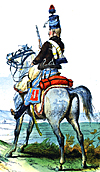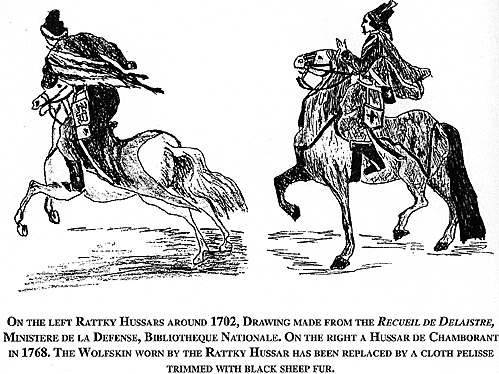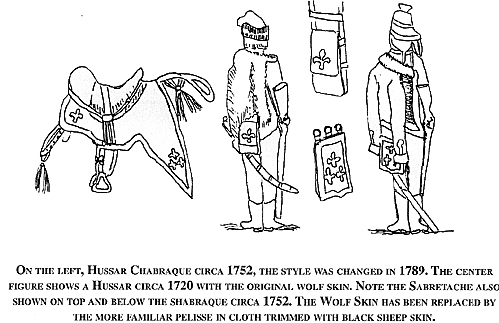
Although the hussars formed a small part of the French cavalry, the corps of the hussars enjoyed somewhat of a special status as in most other armies.
Large Illustration of Chamboran Hussar 1793 (very slow: 177K)
In many minds, the Hussar represents the image of the true beau sabreur exemplified by the legendary Lasalle. It has been reported by some historians that most French cavalrymen of the Napoleonic period dreamed to wear the famous, prestigious, and colorful hussar's pelisse, and the calflength Hungarian boots a la Souvaroff. The prestigious Chasseurs A cheval of the Imperial Guard, in spite of their name, wore a uniform undoubtedly inspired by the hussar's uniform. [1]
After all, the word hussar was more or less equated with bravery. It was a most desirable status with which to impress the ladies! This was obviously a fact of considerable importance to the Napoleonic warrior. Lasalle's famous quote, "A hussar that is not dead at 30 is a bungler" (A hussard qui n'est pas mortei 30 ans est un Jean-foutre!) can be taken as a statement of policy.
There is little doubt that the French hussar of the Napoleonic period tried to live up to the reputation of their arm and died trying to preserve it. The 10th regiment, which was given 25 crosses of the Legion d'Honneur by Napoleon on the eve of the Battle of Lutzen (1813), counted in its ranks only 5 of the newly decorated hussars on the eve of the day after the battle ... The British soldier-historian William Napier [2] wrote the following about the grey-coated 3rd or Esterhazy's Hussars whom he faced in Spain:
Good cavalry they were indeed. But if the French hussars of the Napoleonic period were respected elite cavalry troops it had not been always so....
We all know about the hussars as fine light cavalry of Hungarian origin but where do they come from? It is believed that the word hussar defines the Hungarian cavalrymen recruited in each village in the proportion of one man for twenty families (in Hungarian "Huszar", the twentieth) to complement the militias of Haidouks raised to defend the country against the Turks. In France, many Hungarian were already in the service of Louis the XIIIth but were not yet known under that name. They were simply foreign mercenaries among others and, on top of that, very poor soldiers. Louvois could not tolerate such bad soldiers in the King's armies and they were dismissed.
THE FIRST HUSSAR REGIMENTS IN THE FRENCH ARMY
[1]In France, the history of the hussars begins in 169 1. At that time, some Hungarian deserters were hired as domestics or grooms. Soon they distinguished themselves in raiding the enemy's convoys. Informed of that fact, the King gave to the Baron of Kronenberg, a Hungarian officer in French service, the task of organizing a regiment of hussars. Consequently, the Hussards Royaux were raised in Strasbourg. The regiment included 2 squadrons of 3 companies of 50 men each. The 300 men of the regiment were dressed, armed and mounted in the fashion of their country. The regiment survived until 1791 under the name of Hussars de Bercheney and because of its seniority took the rank of 1st Hussars.
Then, a second regiment of hussars, to be known later as the regiment of Rattky, was given to France in 1701, after it had been organized by the Elector of Bavaria. The regiment was originally commanded by Mr. de SaintGeni6s but in December 1707 became the propriety of Georges Bor, Baron of Rattky. Rattky died in 1743 and the regiment took the name of ApremontLynden. The regiment was disbanded in October 1756 and its squadrons incorporated into the Bercheney, Turpin and Polletzki hussar regiments. Our model, the Chamborant Hussar Regiment, is among the oldest and the most famous hussar regiments in the French army. It was raised by the Comte of Esterhazy per a royal authorization of December 1734 and organized in Strasboj~rg on January 25, 1735. In August 175 1, the regiment was commanded by a Mr. de David and in January became the propriety of the Comte of Turpin-Crisse. In November 1756, the regiment was reinforced by some elements from the Hussards de Beausobre and Hussards de Ferrary and then, in 1758, by two companies of the Hussards de Pollereski who had also been disbanded like the Hussards de Rattky. In February 1761, the regiment became the property of the Marquis de Chamborant, a name that traditionally was going to be kept under the Republic and the Empire while being the 2nd Hussars. In 1761, originated the regiment's motto: "Nobless oblige, Chambaurant tout autant" which can be translated as Nobility obliges, Chambaurant as much.
It is under the name of Chambaurant [3] that the regiment was to acquire its reputation. It should be noted that by 1767, the hussars had grown to 4 permanent regiments but, in French service, they had not yet acquired full recognition or the fame for which they were known during the Empire. In spite of some brilliant actions during the Seven Years War, they were still more or less considered as auxiliary light troops.
1. THE EARLY UNIFORM
The first hussars in French service did not wear the flashy uniforms to which we are accustomed. The above drawings shows the Hussards de Rattky in 1702 and the Hussars de Chamborant in 1768 and the evolution of the Hussar's uniform.
As a matter of fact, we can more or less speak of the lack of uniform of these three hussars. Only one of them wears a fur skin [4] but all have the typical overalls called schavarende usually of a deep light blue. As a matter of fact, the early hussar uniforms are nothing more than the original everyday wear of the Hungarian peasants. The headgear is the famous colpack in its most primitive form. The sabre of oriental origin is curved, which is new to the French army as, until then, all sabres had a straight blade.
2. THE HUSSAR UNIFORM AND THE ORDNANCE OF 1752
The Wars of the Polish Succession (1733-38) and of the Austrian Succession (1740-48) served as a catalyst to internationalize the hussar uniforms since hussars were now part of every major continental army. Only minute details like the color of the headgear distinguished a French hussar from an Austrian hussar and vice-versa which lead to unpleasant surprises in the field. In May 1752, the King of France decided to regulate the hussars uniforms by an ordnance in an attempt to normalize them.
Our next plate shows a Turpin Hussar in 1757. The uniform is in agreement with the ordnance of 1752. When compared to the uniform of the Rattky Hussar, the changes are significant. The new uniform is more in line with the hussar uniform we expect.
In 1748, on the initiative of Maurice de Saxe, the fur bonnet (or colpack) was replaced by the equally Hungarian headgear called the shako. [5] The vest now was more and more often called a dolman in the successive ordnances of 1752,1762, and 1767 and was red in color. The 1752 version is decorated with 18 rows of white tresses sewn on each side of the vest. These tresses fasten the white piped vest. The pointed cuffs are light blue. For that specific regiment, the collar is red piped white.
The wide belt is light blue and tied up in the back and has not changed since 1720.
The wolf skin has been replaced for some time by the pelisse made in this case of light blue cloth piped and decorated with rows of white tresses. A white sheep skin pads the vest and is piped with black sheep skin. The closing system is identical to that of the vest. For parades, the pelisse is worn "flowing" on the left shoulder. It is held in place by a cord of double white thread that ends up on the right with a wood large button that is passed through a buckle formed by the double white thread sewn on the left.
The riding breaches are plain red and are not yet decorated with the fancy decorations of the later years. The Schavarende is used only in the field. The riding boots are still in black leather and are of the style shown on the drawing.
The leather sabretache is of a more modem design and is covered with red cloth piped with white cloth about 1.5 inch wide (18 lignes or about 39mm). In the center, three white fleurs de lys complete its decoration. Three rings are sewn on the top to hold the sabretache from the belt which is not visible on the drawing.
3. THE HUSSAR UNIFORM AND THE ORDNANCES OF 1757 AND 1762
The general look of the hussar has not greatly changed. Only a few details have been altered based on the unhappy experiences in the Seven Years War. In December 1762, the King once more tried to standardize the uniform of all the hussars. According to the new ordnance, the Hussars must all wear a dolman, a green pelisse, and red breeches (a color brought in fashion by the famous Chasseurs de Fischer). The regiments can only be distinguished and identified by the color of the flame attached to their shako, the facing colors and the sabretache. That is not much.
4. THE HUSSAR UNIFORM IN 1789 AND THE REVOLUTION
The pressure to introduce more distinctions to identify each Hussar regiment must have been great. In May 1776, the new king, Louis XVIth, authorized each regiment commander (i.e. each Mestre de Camp [6]) to choose his regiment's colors from a sampler from the Royal Works of Elbeuf (in Normandy).
Mr. de Chamborant set his choice on a reddish brown to which soon the sky blue will be added. These colors will become as famous as the motto: Noblesse oblige, Chamborant autant.
And, of course, the other hussar regiments follow suit and adopt their regimental colors that remained unchanged during the Republic and the Empire.
In 1778, the Hussars finally get full recognition. A ColonelGeneral is finally appointed to command their arm. The honor is given to the Duke of Chartres, the future Philippe-Egalite. [7]
On October 1st, 1786, the first clear and precise ordnance concerning the Hussars' uniform is finally published. The shabraque is completely changed as shown on the drawings and is now made of sheepskin piped in the regimental colors. That type of shabraque had been introduced in France by the famous Chasseurs de Fischer, but it took time for its introduction to the Hussars. The ordnance was still in effect at the beginning of the Revolution and during the Revolution, the only noticeable difference being the replacement of the mirliton by the shako. The uniform of the Chamborant Hussars (2nd Hussars) is shown on the color plate of page 61.
5. The Hussars and the Empire
In 1791, there were six hussar regiments in French service. In Napoleon's army, they were to grow to a total of 14 regiments. The additional regiments were added over time. The 7th and 8th were formed in 1792, the 9th, 10th and 11th in 1793, the 12th in 1794, the 13th in 1795 and finally the 14th in 1814.
The Campaign of 1806 immortalized the reputation of the hussars in the French army. The battle honors of the 2nd regiment, the Hussards de Chamborant, include many Napoleonic battles: Austerlitz, Halle, Crewirz, Mohrungen, Osterode, Friedland, Medellin, Alcabon, Ronda, Leipzig, Montereau just to name a few.
Don't forget, while in campaign, the French hussars, most of the time wore, the green overall (see the Questions & Answers in EE&L 5).
Uniformes No.32, July-August 1976.
[1] A hussar-like uniform was the preferred uniform of the ADC.
[2] Quoted by Colonel Elting, p. 241, in Swords Around the Throne.
[3] The hussards de Chambaurant.
[4] The early hussars did not wear a pelisse but a more primitive fur skin usually taken from a wolf that protected them from the rain and cold weather.
[5] The shako in red felt is ornamented by a long red flame edged white with a white fleur de lys on the front. Most of the time, a color plume (light blue with white top for the Regiment de Turpin) is fixed above the fleur de lys. The hair is long and, since 1720, are brought on the forehead and the back of the head and tied with a black ribbon.
[6] The colonels commanding-regiments were renamed Mestre de Camps de Regiment. The new rank was of short duration as in 1791 it disappeared as the regiments were once more commanded by a colonel.
[7] The Duc de Chartres, alias Philippe d'Orleans, the future Philippe Egalite was the cousin of the King. He voted for the death of the king and himself was guillotined in November 1793.
"Colonel Ferriere never failed to break upon our skirmishers at the most critical moments ... and was continuously proving how much maybe done, even in the most rugged mountains, by a small body of good cavalry.
THE EVOLUTION OF THE HUSSAR UNIFORM
Bibliography
Bucquoy, Cdt. La cavalerie legere, reprint Jacques Grancher, Paris 1980.
Funcken, Liliane and Fred, L'Uniforme et les soldats du Premier Empire, vol. 1, Paris 1968. Misc. notes too numerous to quote.
Endnotes


Back to Empire, Eagles, & Lions Table of Contents Vol. 2 No. 6
Back to EEL List of Issues
Back to MagWeb Master Magazine List
© Copyright 1994 by Emperor's Headquarters
This article appears in MagWeb (Magazine Web) on the Internet World Wide Web.
Other military history articles and gaming articles are available at http://www.magweb.com
